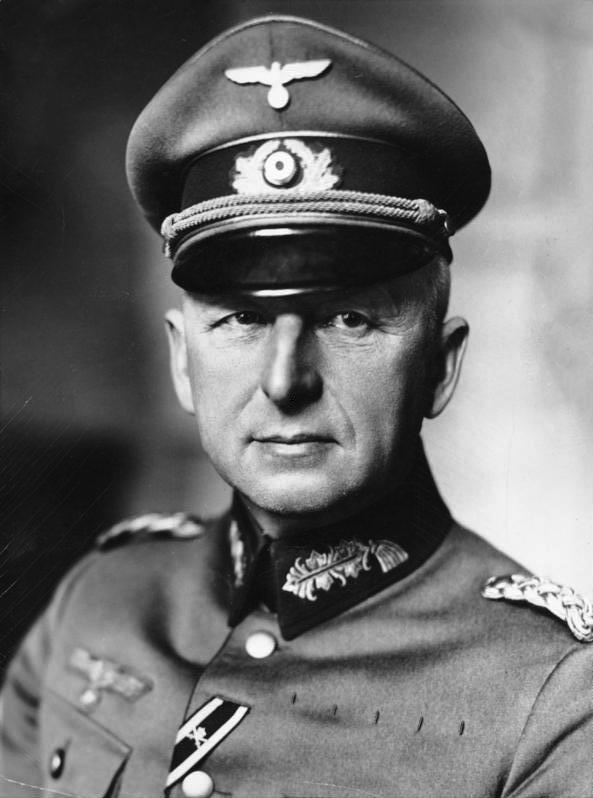Post by Ivan Kolev on Aug 26, 2016 2:36:43 GMT
Today, we talk about a pretty important country in the First World War: Romania.
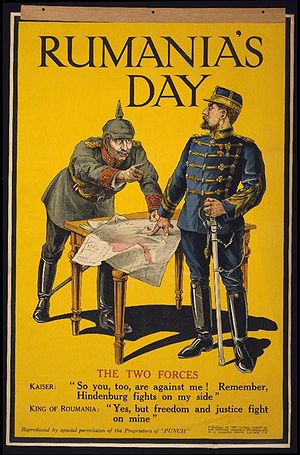
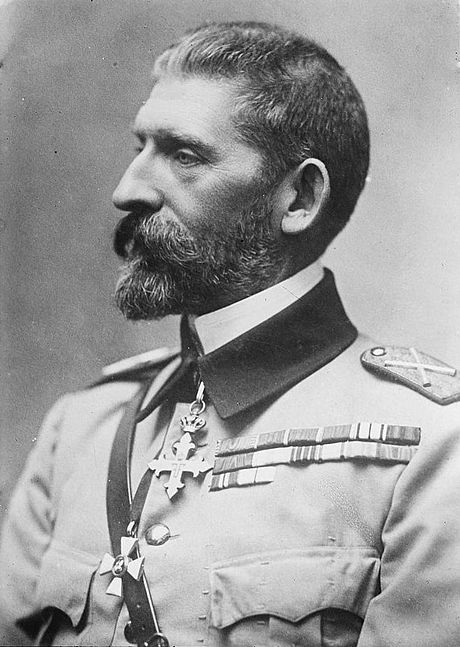

Top: British propaganda poster glorifying Romania's entry into the war by showing Romania standing up against Germany in the name of freedom.
Middle: King Ferdinand I of Romania. He was ranked best beard in the Balkans five years in a row.
Bottom: Transylvania, a desired region by Romanian irredentists.
First, some background information. Romania had been an independent kingdom since 1878, when it officially became independent from the Ottoman Empire. The country faced lots of problems, however. The military was unprepared and unequipped, and many still believed that they were Wallachians or Moldavians instead of Romanians. While unifying the country culturally was much easier than Italy, for example, due to a common language, but it was still not an easy process. Many in the country were uneducated, the country was mostly agricultural at this point as well.
As a result, the national identity was made to center around one thing: Irredentism. If you dont know what irredentism is, its the belief that all areas with your country's culture must be annexed into your nation. The Romanian government thus focused on getting the population behind irredentism, and the regions that the Romanian government wanted by 1900 were the following regions:
-Dobruja (Owned by Bulgaria)
-Transylvania (Owned by Austria-Hungary)
-Bukovina (Owned by Austria-Hungary)
-Bessarabia (Owned by Russia)
While the Romanian government typically wanted to gain these lands at some point, the ruling monarch did not. The monarch, King Carol I, was a relative of the Kaiser, and was pro-German. In 1883, he signed an secret treaty with the Triple Alliance of Germany, Austria-Hungary and Italy stating, among other things, that Romania was to aid Austria if war was to be declared war on them. This was not very popular with the Romanian population, who saw the Austrians as occupiers of their land.
In 1912, the First Balkan War erupted between the Balkan states of Montenegro, Serbia, Bulgaria and Greece and the Ottoman Empire. During the war, the Romanian government signed a treaty with Bulgaria stating that the territory of Silistre (Dobruja) would be ceded to Romania following the war due to all the land Bulgaria would get following the war (Macedonia, Thrace, etc.). After the Serbs refused to cede Macedonia following the independence of Albania, the Bulgarians refused to cede Silistre to Romania. The territorial disputes between Bulgaria and Serbia would then result in the Second Balkan War where it was Serbia and Greece against Bulgaria. While the Bulgarian military faced some success in the fronts against Serbia and Greece, the Romanians invaded from the North to take Silistre, and basically just marched in without resistance. Following more Bulgarian defeats and even the entry of the Ottomans, Bulgaria surrendered, ceding land to the Turks, Serbs, Greeks and Romania, giving Silistre to them. This boosted Romanian national morale and resulted in national fervor across the country.
In 1914, when WWI broke out, Romania became incredibly important, as it could open up a new front against Austria, or open up a front against Russia. King Carol wished to join Germany, but the population and government were fiercely against it. Romania was also important for its oil fields, which would be an incredibly useful asset to either side. In 1915, Romania became even more important when Bulgaria joined the war on the side of Germany. By 1915, Carol had also died, resulting in King Ferdinand I becoming the new monarch of Romania. Unlike his predecessor, Ferdinand was more pro-Entente than pro-German.
The Central Powers offered Bessarabia and parts of Ukraine to Romania if they joined on their side in the war. By 1916, however, the Romanians were clearly not going to join the Central Powers, especially as, by this point, the Austrians seemed to be in dire straits, with the Brusilov Offensive inflicting massive damage on the empire, as with a renewed Italian offensive against them by the Duke of Aosta and Luigi Cadorna. Added to that, the pressure placed upon the Bulgarians in the Southern Balkans and the Ottomans in the Caucuses and the Levant seemed to the Romanians as a very opportune moment to invade.
The Romanians, in 1916, requested that, in return for joining the Entente, would, among other things, gain Transylvania and Bukovina from Austria, have the Russians send troops to Dobruja, start a renewed offensive in Salonika, and for Allied supplies to reach Romania. In August, the Entente agreed, resulting in the secret Treaty of Bucharest. The Treaty of Bucharest stated that Romania had to declare war by August 28th and could not make a separate peace. On August 27th, the Romanians declared war on Austria-Hungary. Within three days, the Germans, Bulgarians, and Ottomans all declared war on Romania. Romania was now involved in the war to end all wars.
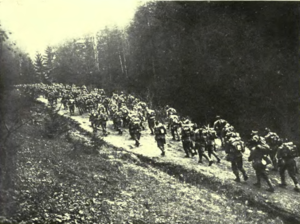
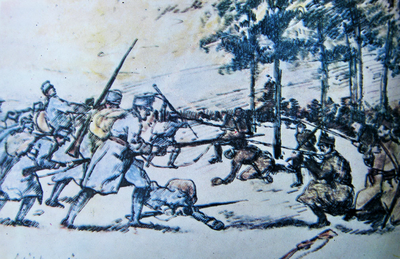
Top: Romanian troops advancing into Transylvania.
Bottom: First Battle of Oituz.
The Romanian military was fairly large, reaching up to a total of 650,000 men, but the army was plagued by corruption and the army was not nearly as trained or prepared for war as the Germans. Despite this, starting on August 27th, three Romanian armies swept into Transylvania. The Romanians faced very little resistance initially, and only from the Austro-Hungarians in Transylvania if there was any. The Romanians were usually treated as liberators by the native, typically Romanian, population of Transylvania, who often gave the Romanians directions and provisions as they moved onward. By September, the major city of Cluj was at risk of falling, and the Central Powers decided that they had to react to the Romanian invasion. The Entente assumed that the Romanians would just be able to march in without much resistance as the Battle of the Somme and the Brusilov Offensive was holding down many German divisions, the Battle of Salonika was holding down Bulgarian divisions, and pressure from the Caucasus and Levant would be able to tie up the Ottomans. Despite this, the Central Powers launched a counterattack, specifically from Bulgaria, as almost the entire Romanian military was off fighting in Transylvania by September. From Transylvania, Erich von Falkenhayn commanded eight divisions against Romania and August von Mackensen commanded tri-national force of Bulgarians, Germans and Ottomans from Dobruja. The Romanian line started to fold and collapse, and the Central Powers counterattacked. The Russians provided some divisions for Romania in Moldavia, but these turned out to be not of much use.
By October, the Romanian military switched from an offensive mindset to a defensive one, planning to hold from the Carpathian mountains in the East and from the Danube to the South. The Romanians proved successful in several battles, including the First Battle of Oituz and the Battle of Targu Jiu, but the Central Power's forces continued to advance. By November, German troops had taken Craiova in Wallachia, and Bucharest had fallen on December 6th, with the Romanians also destroying their oil fields. For the rest of the campaign, the Romanians were able to hold Moldavia, but had to leave Wallachia and Dobruja. By 1917, the Romanians proved much more successful in battle, but after the October Revolution and the subsequent Russian withdrawal from the war, the Romanians had no choice but to make a separate peace with the Central Powers, signing the Foscani Armistice on December 9th, 1917.
On May 7th, 1918, the Treaty of Bucharest was signed between Romania and the Central Powers. The treaty stated that:
-The Ploesti Oil Fields must be open for the Central Powers, and will be repaired by the Central Powers.
-Several border territories will be ceded to Austria-Hungary
-Silistre will be ceded to Bulgaria
-Two million tons of grains will be supplied to Germany.
The Ploesti Oil Fields would pump a million tons of oil by the end of the war for the Germans and the two million tons of grain would be incredibly beneficial for the Germans in the last year of fighting. A new German supported Prime Minister, Alexandru Marghiloman, signed the treaty, but King Ferdinand refused to sing the treaty. The Romanians also united with Bessarabia following the chaos of the Russian revolution.
Following the successful Entente breakthrough on the Thessaloniki Front which knocked Bulgaria out of the war, the Romanians re-entered the war on November 10th, 1918, the day before the armistice was signed with Germany on November 11th. On November 28th, Romanian nationalists in Bukovina proclaimed a union with Romania, followed by a union of Transylvania with Romania by the Romanians and Germans in the region. The Treaty of Versailles recognized these unions as examples of popular sovereignty. Silistre was also returned to Romania under the Treaty of Versailles. The Hungarians living in Transylvania were not content with the union, however, and this dispute over Transylvania would ultimately result in the Romanian-Hungarian War of 1919 between Hungary and Romania, ultimately resulting the enforcing of the Treaty of Trianon's terms on Hungary and the complete recognition of Romanian rule of Transylvania.
Romania gained a massive amount from the First World War, but at a steep cost. 6% of all Entente casualties were from Romania, and the Romanians took 535,000 casualties. Following the war, however, Romanian irredentists were incredibly happy, as all the territory that they wished to gain, Bessarabia, Dobruja, Bukovina and Transylvania, were ceded to Romania. This caused a massive increase in Romanian nationalism and pride following the war.



Top: British propaganda poster glorifying Romania's entry into the war by showing Romania standing up against Germany in the name of freedom.
Middle: King Ferdinand I of Romania. He was ranked best beard in the Balkans five years in a row.
Bottom: Transylvania, a desired region by Romanian irredentists.
First, some background information. Romania had been an independent kingdom since 1878, when it officially became independent from the Ottoman Empire. The country faced lots of problems, however. The military was unprepared and unequipped, and many still believed that they were Wallachians or Moldavians instead of Romanians. While unifying the country culturally was much easier than Italy, for example, due to a common language, but it was still not an easy process. Many in the country were uneducated, the country was mostly agricultural at this point as well.
As a result, the national identity was made to center around one thing: Irredentism. If you dont know what irredentism is, its the belief that all areas with your country's culture must be annexed into your nation. The Romanian government thus focused on getting the population behind irredentism, and the regions that the Romanian government wanted by 1900 were the following regions:
-Dobruja (Owned by Bulgaria)
-Transylvania (Owned by Austria-Hungary)
-Bukovina (Owned by Austria-Hungary)
-Bessarabia (Owned by Russia)
While the Romanian government typically wanted to gain these lands at some point, the ruling monarch did not. The monarch, King Carol I, was a relative of the Kaiser, and was pro-German. In 1883, he signed an secret treaty with the Triple Alliance of Germany, Austria-Hungary and Italy stating, among other things, that Romania was to aid Austria if war was to be declared war on them. This was not very popular with the Romanian population, who saw the Austrians as occupiers of their land.
In 1912, the First Balkan War erupted between the Balkan states of Montenegro, Serbia, Bulgaria and Greece and the Ottoman Empire. During the war, the Romanian government signed a treaty with Bulgaria stating that the territory of Silistre (Dobruja) would be ceded to Romania following the war due to all the land Bulgaria would get following the war (Macedonia, Thrace, etc.). After the Serbs refused to cede Macedonia following the independence of Albania, the Bulgarians refused to cede Silistre to Romania. The territorial disputes between Bulgaria and Serbia would then result in the Second Balkan War where it was Serbia and Greece against Bulgaria. While the Bulgarian military faced some success in the fronts against Serbia and Greece, the Romanians invaded from the North to take Silistre, and basically just marched in without resistance. Following more Bulgarian defeats and even the entry of the Ottomans, Bulgaria surrendered, ceding land to the Turks, Serbs, Greeks and Romania, giving Silistre to them. This boosted Romanian national morale and resulted in national fervor across the country.
In 1914, when WWI broke out, Romania became incredibly important, as it could open up a new front against Austria, or open up a front against Russia. King Carol wished to join Germany, but the population and government were fiercely against it. Romania was also important for its oil fields, which would be an incredibly useful asset to either side. In 1915, Romania became even more important when Bulgaria joined the war on the side of Germany. By 1915, Carol had also died, resulting in King Ferdinand I becoming the new monarch of Romania. Unlike his predecessor, Ferdinand was more pro-Entente than pro-German.
The Central Powers offered Bessarabia and parts of Ukraine to Romania if they joined on their side in the war. By 1916, however, the Romanians were clearly not going to join the Central Powers, especially as, by this point, the Austrians seemed to be in dire straits, with the Brusilov Offensive inflicting massive damage on the empire, as with a renewed Italian offensive against them by the Duke of Aosta and Luigi Cadorna. Added to that, the pressure placed upon the Bulgarians in the Southern Balkans and the Ottomans in the Caucuses and the Levant seemed to the Romanians as a very opportune moment to invade.
The Romanians, in 1916, requested that, in return for joining the Entente, would, among other things, gain Transylvania and Bukovina from Austria, have the Russians send troops to Dobruja, start a renewed offensive in Salonika, and for Allied supplies to reach Romania. In August, the Entente agreed, resulting in the secret Treaty of Bucharest. The Treaty of Bucharest stated that Romania had to declare war by August 28th and could not make a separate peace. On August 27th, the Romanians declared war on Austria-Hungary. Within three days, the Germans, Bulgarians, and Ottomans all declared war on Romania. Romania was now involved in the war to end all wars.


Top: Romanian troops advancing into Transylvania.
Bottom: First Battle of Oituz.
The Romanian military was fairly large, reaching up to a total of 650,000 men, but the army was plagued by corruption and the army was not nearly as trained or prepared for war as the Germans. Despite this, starting on August 27th, three Romanian armies swept into Transylvania. The Romanians faced very little resistance initially, and only from the Austro-Hungarians in Transylvania if there was any. The Romanians were usually treated as liberators by the native, typically Romanian, population of Transylvania, who often gave the Romanians directions and provisions as they moved onward. By September, the major city of Cluj was at risk of falling, and the Central Powers decided that they had to react to the Romanian invasion. The Entente assumed that the Romanians would just be able to march in without much resistance as the Battle of the Somme and the Brusilov Offensive was holding down many German divisions, the Battle of Salonika was holding down Bulgarian divisions, and pressure from the Caucasus and Levant would be able to tie up the Ottomans. Despite this, the Central Powers launched a counterattack, specifically from Bulgaria, as almost the entire Romanian military was off fighting in Transylvania by September. From Transylvania, Erich von Falkenhayn commanded eight divisions against Romania and August von Mackensen commanded tri-national force of Bulgarians, Germans and Ottomans from Dobruja. The Romanian line started to fold and collapse, and the Central Powers counterattacked. The Russians provided some divisions for Romania in Moldavia, but these turned out to be not of much use.
By October, the Romanian military switched from an offensive mindset to a defensive one, planning to hold from the Carpathian mountains in the East and from the Danube to the South. The Romanians proved successful in several battles, including the First Battle of Oituz and the Battle of Targu Jiu, but the Central Power's forces continued to advance. By November, German troops had taken Craiova in Wallachia, and Bucharest had fallen on December 6th, with the Romanians also destroying their oil fields. For the rest of the campaign, the Romanians were able to hold Moldavia, but had to leave Wallachia and Dobruja. By 1917, the Romanians proved much more successful in battle, but after the October Revolution and the subsequent Russian withdrawal from the war, the Romanians had no choice but to make a separate peace with the Central Powers, signing the Foscani Armistice on December 9th, 1917.
On May 7th, 1918, the Treaty of Bucharest was signed between Romania and the Central Powers. The treaty stated that:
-The Ploesti Oil Fields must be open for the Central Powers, and will be repaired by the Central Powers.
-Several border territories will be ceded to Austria-Hungary
-Silistre will be ceded to Bulgaria
-Two million tons of grains will be supplied to Germany.
The Ploesti Oil Fields would pump a million tons of oil by the end of the war for the Germans and the two million tons of grain would be incredibly beneficial for the Germans in the last year of fighting. A new German supported Prime Minister, Alexandru Marghiloman, signed the treaty, but King Ferdinand refused to sing the treaty. The Romanians also united with Bessarabia following the chaos of the Russian revolution.
Following the successful Entente breakthrough on the Thessaloniki Front which knocked Bulgaria out of the war, the Romanians re-entered the war on November 10th, 1918, the day before the armistice was signed with Germany on November 11th. On November 28th, Romanian nationalists in Bukovina proclaimed a union with Romania, followed by a union of Transylvania with Romania by the Romanians and Germans in the region. The Treaty of Versailles recognized these unions as examples of popular sovereignty. Silistre was also returned to Romania under the Treaty of Versailles. The Hungarians living in Transylvania were not content with the union, however, and this dispute over Transylvania would ultimately result in the Romanian-Hungarian War of 1919 between Hungary and Romania, ultimately resulting the enforcing of the Treaty of Trianon's terms on Hungary and the complete recognition of Romanian rule of Transylvania.
Romania gained a massive amount from the First World War, but at a steep cost. 6% of all Entente casualties were from Romania, and the Romanians took 535,000 casualties. Following the war, however, Romanian irredentists were incredibly happy, as all the territory that they wished to gain, Bessarabia, Dobruja, Bukovina and Transylvania, were ceded to Romania. This caused a massive increase in Romanian nationalism and pride following the war.




